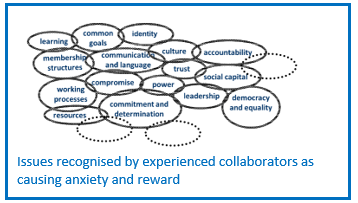You are here
- Home
- Resources
- Small Charity Week 2020
- Section 2: Introduction to Collaboration - why is it important in both the current and future context?
Section 2: Introduction to Collaboration - why is it important in both the current and future context?
This section will take approximately 45 minutes to work through and there are links to additional materials if you’d like to spend more time exploring the topics in question.
Collaboration can be described as “any situation in which people are working across organisational boundaries towards some positive end” (Huxham and Vangen, 2005, p.4).
It’s clear from the previous section and from how the voluntary sector has worked in recent years that the pressure to collaborate – to work across organisational boundaries – is a fact of life for many voluntary sector organisations. Often these collaborations are with public sector bodies such as local councils or the NHS.
In the next video, Carol, Ian, and Clare discuss the importance of collaboration and we’ll hear more from them throughout this section.
‘The Importance of Collaboration in the Next Stages of Covid-19 Response’ (9:30 minutes)
Although the pressure to collaborate is seemingly ever present we know from previous research that it is very hard to achieve positive results in practice. There is often an inherent assumption that there will be automatic advantages in working collaboratively – achieving something together that individual organisations could not achieve on their own – however, the difficulties inherent in working in a collaborative way mean that at times efforts stall and very little is achieved – what is referred to as collaborative ‘inertia’.
In the rest of this section, Professor Siv Vangen expands on the concept of collaborative advantage and inertia and explores whether collaboration can offer a guiding light for the voluntary sector as we look towards the future following the Covid-19 pandemic.
Can Collaborative Advantage Offer a Guiding Light for the Voluntary Sector as it Enters a Period of Increasing Uncertainty and Unknowns Following Covid-19
Professor Siv Vangen
The notion of collaborative advantage – that synergy can be achieved by combining the unique resources and expertise of one organisation with that of others – is not hard to subscribe to.
Collaborative Advantage: Something is achieved that could not have been achieved without the collaboration.
The pooling of different organisations’ resources – for example a tried and tested approach by one organisation with the knowledge of a specific community or client group of another with access to a budget by a third – enable organisations to achieve something that none of them could achieve on their own. In principle therefore, collaboration provides organisations with the opportunity to address those highly complex social issues that are beyond the reach of any organisation to address effectively on its own. When collaborations work well, they can provide hope and energy for organisations and individuals who seek to make a difference.
‘Examples of Collaboration: Existing and Emerging’ (7:53 minutes)
In this video Clare and Ian talk about some of the collaborations they have been part of in recent months as part of the voluntary sector’s response to Covid-19 in Milton Keynes.
Yet achieving collaborative advantage is not a forgone conclusion. The very differences that create the potential for collaborative advantage also inevitably create contradictions and tensions. Working collaboratively can be frustrating, painful and slow.
Collaborative Inertia: The rate of output is slow… even successful outcomes involve pain and hard grind.
We call this collaborative inertia. Our research suggests that collaboration should not be entered into lightly, or indeed, that organisations shouldn’t collaborate unless they have to. Even when achieving collaborative advantage is a real possibility, it is worth remembering that collaborations are highly ‘paradoxical’ and that making something happen together with other organisations will usually be much harder than doing something on your own.
Paradox in Collaboration – Extract from Vangen (2017, p.7-8):
…the notion of paradox recognizes collaborative contexts as complex webs of overlapping, dynamic, hierarchies and systems that comprise competing designs and processes that are necessary to achieve desired outcomes.
The idea that collaborative contexts are inherently paradoxical containing ‘persistent contradiction between interdependent elements’ (Schad et al, 2016, 6) is recognized implicitly and explicitly in extant literature. For example, research suggests, paradoxically, that both similarities and difference in member organizations’ goals influence the success of a collaboration (Vangen and Huxham, 2012).
When partners have similar organizational goals, agreement on joint collaboration goals can follow more easily (O’Leary and Bingham, 2009; Thomson and Perry, 2006). Yet similar goals suggest that partners may have competitive interests that leave them reluctant to cooperate and share information (Tschirhart, et al, 2005; Provan and Kenis, 2008). For example, community groups and nonprofit organizations often compete for scarce resources. Hence the need to convince funders about their organization’s ability to produce public and social value, over and above that of potential partners, can make collaboration difficult in practice.
Differences in goals also facilitate collaboration as it implies greater synergies from diversity of resources but this can also lead partners to seek different and sometimes conflicting outcomes (Agranoff and McGuire, 2001; Percival, 2009). For example, faith-based organizations, community groups and schools frequently have conflicting value bases and goals. Yet such diverse institutions are often partners in implementing public policy pertaining to issues such as public health, social wellbeing and area regeneration where their value bases and goals would suggest different priorities and approaches. This ‘goals paradox’ shows that goal congruence and diversity is in tension rendering the management of goals challenging in practice.
Professor Siv Vangen: 'Experiences of Collaboration - Advantage and Inertia (2:22)
In this video from the CVSL launch event in 2016 Siv summarises the concepts of collaborative advantage and inertia drawing on examples from her research with practitioners.
If collaboration is seen as essential for the voluntary sector moving forward following COVID-19, how can individuals and organisations prepare themselves for the challenges that working collaboratively will entail?
Our research suggests that collaboration poses some significant operational challenges and that there are some which are identified repeatedly by experienced collaborators. We would like to suggest that having a good understanding of what these key challenges are, along with some help in thinking about how to address them, may offer potentially valuable insight for senior managers as they look beyond COVID-19 to a future with considerable uncertainly and unknowns for the voluntary sector.
Most commonly, challenges include managing inherently different organisational goals, navigating diverse professional and organisational cultures including ways of communicating, planning and implementing projects, compromising on embedded values, addressing power imbalances and trust issues, and understanding what effective leadership looks like in collaborative contexts.
 All of these, and more, pose significant management and leadership challenges so that in practice, working collaboratively can be too slow and successful outcomes can come at a significant cost to some if not all of the collaborating partners. Nevertheless, against this backdrop, collaboration may be the only option for addressing some of the most complex social challenges facing the voluntary sector over the next foreseeable future. It is at least possible therefore that the better individuals understand the challenges inherent in collaborative working, the better skilled they are about addressing those challenges, the better their collaborative endeavors will be. You can find a text that explores these issues in a bit more detail in 'Building and using the theory of collaborative advantage' (request access by clicking the ‘request a copy’ link, this is free of charge).
All of these, and more, pose significant management and leadership challenges so that in practice, working collaboratively can be too slow and successful outcomes can come at a significant cost to some if not all of the collaborating partners. Nevertheless, against this backdrop, collaboration may be the only option for addressing some of the most complex social challenges facing the voluntary sector over the next foreseeable future. It is at least possible therefore that the better individuals understand the challenges inherent in collaborative working, the better skilled they are about addressing those challenges, the better their collaborative endeavors will be. You can find a text that explores these issues in a bit more detail in 'Building and using the theory of collaborative advantage' (request access by clicking the ‘request a copy’ link, this is free of charge).
As we look to the future, there are several layers of inter-woven and unprecedented uncertainty and unknows. The implications and ramifications of COVID-19 on our societies across the globe are unknown. There is much concern about the need to rebuild societies along with early speculations of the structures of civil society, but what this might look like as we come out of the lockdown and how significant the changes will be, are not known. It follows that the nature of the problems are unknown. While we can be confident that social issues to be addressed will be complex and multi-faceted, how we begin to understand the ramifications of those problems along with the ability and capacity of the voluntary sector to address them are not known. As we are certainly heading for a deep recession, the resources available to address these hard to define social issues, are likely to be even more limited than before. While there is an understanding that organisations and sectors need to work together to address them, less resources along with greater needs suggest an intensification of competing organisational objectives which will make it harder still to pin down and agree on shared objectives for collaborative working.
Most would argue that being clear about the nature of a problem and having shared objectives for how to address them collaboratively is essential. Yet in practice, this creates a dilemma for those who seek to initiate and sustain collaborative working. And this dilemma will be no less real as we come out of lockdown and look to engage in more inter-organisational and cross-sector collaborative working. The nub of the dilemma is that collaborative advantage is born out organisations’ different areas of expertise, assets, knowhow, priorities, cultures and values. Such different organisations rarely have the same goals and needs, so reaching agreement on what the problem is and how to address it collaboratively can be difficult. It may take several rounds of bringing different potential partners into negotiation simply to initiate collaboration. Let alone the many operational challenges of sustaining the collaboration, the fact that future post COVID19 is highly uncertain and unknown, suggest that agreement on the problem and how to address it collaboratively, may also shift at an unprecedented rapid speed, disrupting again the relationship between the problem definition and how to address it. In a short article we have outlined the dynamic inter-relationship between collaboration partners and purpose.
Reflection
If you’re reflecting on these issues in relation to your own practice and would some more information or support, please get in touch.
Next: Section 3 discusses an important aspect of collaborative working – Leaders and Leadership.
Proceed to Section 3




